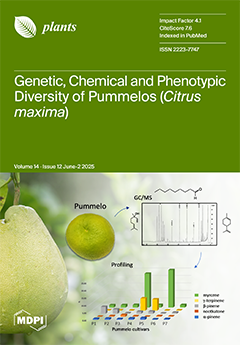The fig (
Ficus carica L.) is one of the oldest fruit crops cultivated in arid and semi-arid regions, valued for both its nutritional and economic importance; thus, ensuring sustainable fig production under climate change conditions is very important, as water scarcity increasingly affects fruit quality and production. Selecting and preserving resilient varieties among traditional varieties, representing centuries of local adaptation, is a vital strategy for addressing the challenges driven by climate change. In this context, this study assessed the physiological and biochemical parameters of the leaves of four fig landrace varieties (Fassi, Ghouddane, Nabout, and Ounq Hmam) grown in three different Mediterranean transitional zones of northern Morocco (Chefchaouen, Taounate, and Taza), during a single timepoint assessment conducted in late August 2023. The combined effects of location, variety, and their interactions on chlorophyll fluorescence (F
v/F
m), Soil Plant Analysis Development (SPAD) index, total chlorophyll content (ChlT), canopy temperature depression (CTD), proline content, protein content, total soluble sugar (TSS), hydrogen peroxide (H
2O
2), and malondialdehyde (MDA) were determined. Significant variation was observed among varieties and locations, with the location effect being observed for proline content, protein content, TSS, CTD, and ChlT, while variety had a stronger influence on SPAD, F
v/F
m, H
2O
2, and MDA. The results showed that Nabout and Ounq Hmam varieties had the greatest photosynthetic efficiency, as indicated by their elevated SPAD index, ChlT, and F
v/F
m values, and showed lower sensitivity to oxidative stress (low proline content, H
2O
2, and MDA levels). In contrast, Ghouddane and Fassi displayed better stress tolerance, presenting higher levels of oxidative stress markers. Among locations, Chefchaouen showed the highest protein, TSS, H
2O
2, and MDA levels, reflecting active stress tolerance mechanisms. These variations were confirmed by principal component analysis, which revealed a clear separation between photosynthetically efficient varieties (Nabout and Ounq Hmam) and stress-tolerant varieties (Ghouddane and Fassi). More than a conventional crop physiology study, this work highlights the adaptive strategies in traditional Mediterranean fig germplasm that could be crucial for climate change adaptation. While our findings are limited to a single season, they offer valuable, practical insights that can inform grower decision-making in the near term, especially when considered alongside local knowledge and additional research.
Full article






